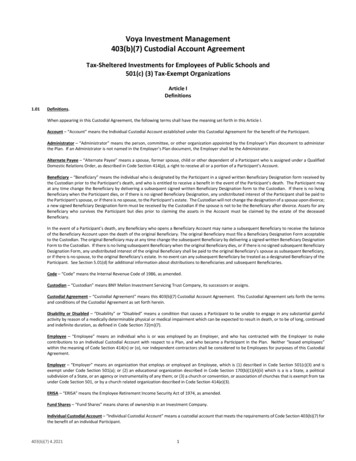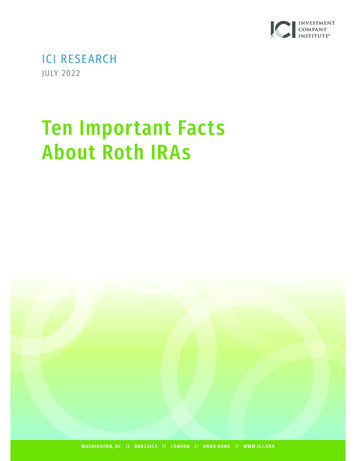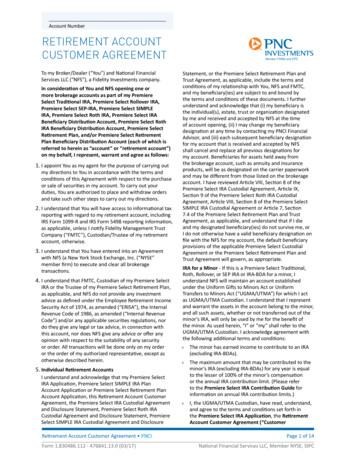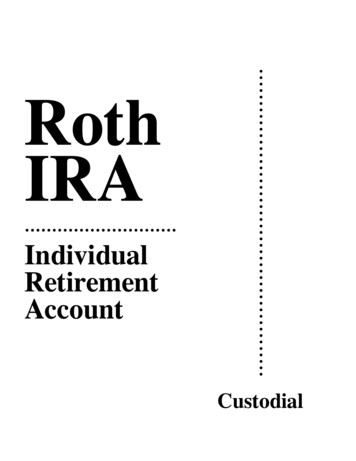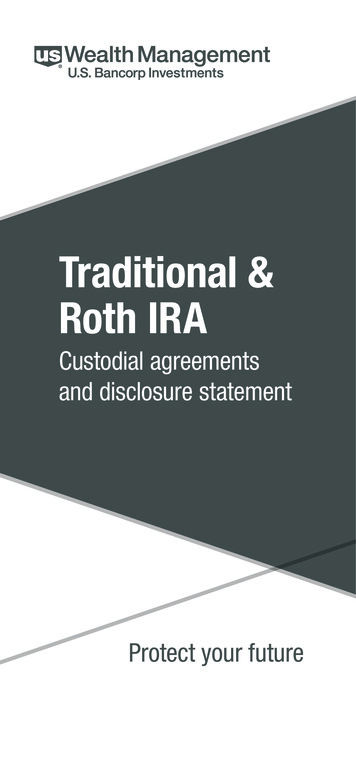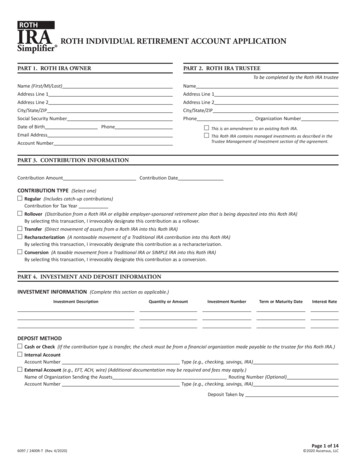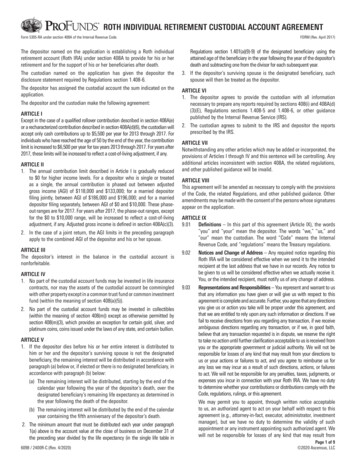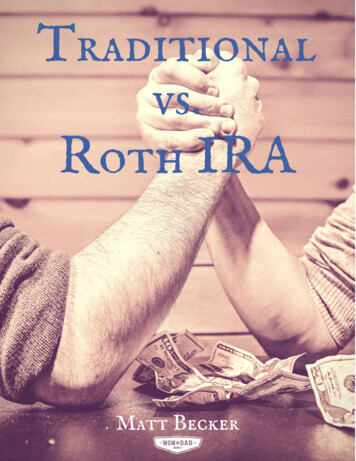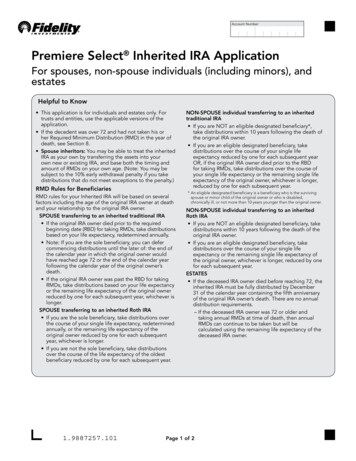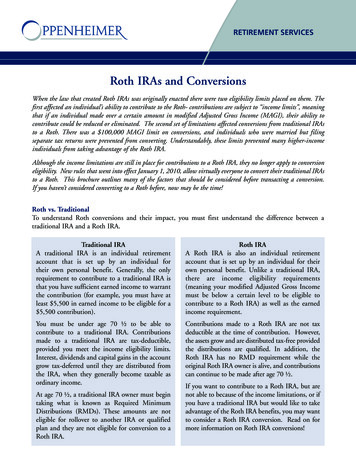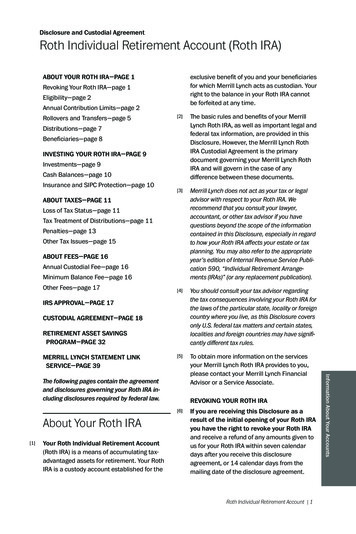
Transcription
Disclosure and Custodial AgreementRoth Individual Retirement Account (Roth IRA)exclusive benefit of you and your beneficiariesfor which Merrill Lynch acts as custodian. Yourright to the balance in your Roth IRA cannotbe forfeited at any time.About YouR Roth iRA—pAge 1Revoking Your Roth IRA—page 1Eligibility—page 2Annual Contribution Limits—page 2Rollovers and Transfers—page 5[2]ﬔe basic rules and benefits of your MerrillLynch Roth IRA, as well as important legal andfederal tax information, are provided in thisDisclosure. However, the Merrill Lynch RothIRA Custodial Agreement is the primarydocument governing your Merrill Lynch RothIRA and will govern in the case of anydifference between these documents.[3]Merrill Lynch does not act as your tax or legaladvisor with respect to your Roth IRA. Werecommend that you consult your lawyer,accountant, or other tax advisor if you havequestions beyond the scope of the informationcontained in this Disclosure, especially in regardto how your Roth IRA affects your estate or taxplanning. You may also refer to the appropriateyear’s edition of Internal Revenue Service Publication 590, “Individual Retirement Arrangements (IRAs)” (or any replacement publication).[4]You should consult your tax advisor regardingthe tax consequences involving your Roth IRA forthe laws of the particular state, locality or foreigncountry where you live, as this Disclosure coversonly U.S. federal tax matters and certain states,localities and foreign countries may have significantly different tax rules.[5]To obtain more information on the servicesyour Merrill Lynch Roth IRA provides to you,please contact your Merrill Lynch FinancialAdvisor or a Service Associate.Distributions—page 7Beneficiaries—page 8investing YouR Roth iRA—pAge 9Investments—page 9Cash Balances—page 10Insurance and SIPC Protection—page 10About tAxes—pAge 11Loss of Tax Status—page 11Tax Treatment of Distributions—page 11Penalties—page 13Other Tax Issues—page 15About Fees—pAge 16Annual Custodial Fee—page 16Minimum Balance Fee—page 16Other Fees—page 17iRs AppRovAl—pAge 17CustoDiAl AgReement—pAge 18RetiRement Asset sAvingspRogRAm—pAge 32meRRill lYnCh stAtement linkseRviCe—pAge 39Revoking YouR Roth iRA[6]About Your Roth IRA[1]Your Roth individual Retirement Account(Roth IRA) is a means of accumulating taxadvantaged assets for retirement. Your RothIRA is a custody account established for theif you are receiving this Disclosure as aresult of the initial opening of your Roth iRAyou have the right to revoke your Roth iRAand receive a refund of any amounts given tous for your Roth IRA within seven calendardays a er you receive this disclosureagreement, or 14 calendar days from themailing date of the disclosure agreement.Roth Individual Retirement Account 1information About Your Accountsﬔe following pages contain the agreementand disclosures governing your Roth IRA including disclosures required by federal law.
[7]If you revoke your Roth IRA within this period,the amount returned to you would not includean adjustment for any sales commissions,administrative expenses or other fees or fluctuations in market value.[8]You must revoke in writing to:[14]In addition to the amounts described above,you may make additional contributions specifically authorized by statute — such as repayments of qualified reservist distributions,repayments of certain plan distributions madeon account of a federally declared disasterand certain amounts received in connectionwith the Exxon Valdez litigation. Also, qualifiedrollover contributions include (i) all or part of amilitary death gratuity or service members’group life insurance (“SGLI”) payment if thecontribution is made within one year ofreceiving the gratuity or payment. Such contributions are disregarded for purposes of theone-rollover-per-year rule under Tax CodeSection 408(d)(3)(B); and (ii) all or part of anairline payment (as defined in Section 125 ofthe Worker, Retiree, and Employer RecoveryAct of 2008) received by certain airlineemployees if the contribution is made within180 days of receiving the payment.[15]Your full contribution may be no more than100% of your compensation (as described onpage 4), if less than the dollar limits above. Ifyour compensation, however, is less than yourspouse’s and you file a joint tax return, youmay add your spouse’s compensation inexcess of his or her Roth IRA and traditionalIRA contributions to your compensation.[16]Your allowable contribution is also determinedby your tax-filing status, modified adjustedgross income (modified AGI) and contributions, if any, made to your traditional IRAs forthe year (excluding SEP and SIMPLE contributions).[17]Beginning for 2007, the 95,000 and 150,000 modified AGI Limits for full contributions will be adjusted by the IRS for cost ofliving changes a er 2005, rounded to thenearest multiple of 1,000. ﬔe modified AGILimits above which no contribution ispermitted (i.e., 110,000 and 160,000) willnot be independently increased by a cost ofliving adjustment. However, the modified AGIrange for determining “partial contributions”will remain at 15,000 (single/head ofhousehold) and 10,000 (married- jointreturn/qualifying widow(er)) over the fullcontribution limits.Manager, Retirement Plan New AccountsMerrill Lynch, Pierce, Fenner & Smith Inc.1400 Merrill Lynch DriveNJ2-140-01-03 Pennington, NJ 08534-4128[9]Make sure your revocation notice is postmarked, certified or registered prior to the endof the revocation period.[10]If you have any questions, contact yourFinancial Advisor or a ServiceAssociate at (800) MERRILL.eligibilitY[11][12]You may make annual contributions to a RothIRA, as long as you comply with the rules forannual contributions outlined below. Like atraditional IRA, contributions may be made byor on behalf of eligible minors. ﬔere is noupper age limit for making annual contributions to a Roth IRA.Regardless of whether you may make annualcontributions, under the rules outlined below,you may be eligible to make a transfer orrollover from another Roth IRA, a conversionfrom a traditional IRA, or a rollover from aqualified employer plan, subject to the applicable rules (see About Your Roth IRA Rollovers and Transfers).AnnuAl ContRibution limits[13]tax Yearsbeginningunder Age 50Age 50 and over2008 and later 5,000 6,000ﬔe 5,000 contribution limit shown in thetable above for tax years a er 2008 is to beadjusted for changes in the cost of living. Anycost of living adjustments will be roundeddown to the next lower multiple of 500.ﬔose cost of living adjustments will also applyto the 5,000 portion of the 6,000 contribution limits for individuals age 50 and over.2 Roth Individual Retirement Account
ﬔe 9% deduction for qualified domesticproduction activities.Calculating your maximum contribution[18]Follow these steps to calculate the maximumamount you may contribute each year to yourRoth IRA.Subtract: Any income from rolling over or converting atraditional IRA to a Roth IRAstep 1.Calculate your modified Agi by locating the“adjusted gross income” line on your IRS Form1040 and adding or subtracting the itemslisted below.If you receive Social Security or RailroadRetirement benefits, use the worksheets in IRSPublication 590 to calculate your modified AGI.step 2.Note that if you are married and filing a jointreturn, your modified AGI is based on the incomeof you and your spouse.match your modified Agi and filing statusagainst the following tableto see if you are eligible to make a full orpartial contribution or are noteligible to make a contribution. If you areeligible to make a partial contribution, go toStep 3. If you are eligible to make a full contribution and you make contributions for theyear to a traditional IRA, go to Step 4. If youare not eligible to make a contribution or youare eligible to make a full contribution and didnot make any traditional IRA contributions forthe year, you can stop with this step.Add: Traditional IRA deductions Foreign earned income exclusions Foreign housing exclusions Interest exclusions on U.S. savings bondsused to pay higher education expenses Adoption assistance program exclusions Deductions for qualified education loaninterest Before 2013, deductions for qualified tuitionand related expenses(b)(C)Filing stAtusmoDiFieD AgiContRibutionpeRmitteDSingle/Head of Household 0–95,000 95,000–110,000 110,000 or moreFullPartialNoneMarried—Joint Return/Qualifying Widow(er) 0–150,000 150,000–160,000 160,000 or moreFullPartialNoneMarried—Separate Return1 0–10,000 10,000 or morePartialNoneIf you are married, filing a separate return, and did not live with your spouse at any time during the year, you aretreated as Single/Head of Household for purposes of calculating your contribution.Roth Individual Retirement Account 3information About Your Accounts1(A)
You may make a 200 minimum contribution,as long as your calculated contribution ismore than 0. For example, if you determinedyour contribution is 133, you may stillcontribute 200.step 3.if your are eligible to make a partial contribution, complete the following worksheet:exAmpleIf you have made no contributions to a traditional IRA, your calculation is complete.Otherwise, go to Step 4.Enter the highestmodified AGI for apartial contributionfor your filing statusfor the year,e.g., 110,000, 160,000 or 10,000:Subtract yourmodified AGI(combined,if married andfiling jointly):WoRksheetstep 4. 110,000[] Your full contribution (see Annual ContributionLimits table and compensation limit) reducedby your traditional IRA contributions; or 98,000[]– 12,000[]Divide by 15,000if single/head ofhousehold, or 10,000 if married(joint or separatereturn) or qualifyingwidow(er) 15,000[]0.8000[]3,000[]Subtotal:Subtotal:Multiply by yourfull contributionlimit.See AnnualContributionLimits andCompensationLimits onprevious page(s)total permittedcontribution:if you made contributions to a traditionalIRA, your maximum annual Roth IRAcontribution is the lesser of:x 2,400[ Your partial contribution calculated underStep 3.[19]Please note your eligibility to contribute to a RothIRA is not affected by your coverage under anemployer sponsored retirement plan. Also,voluntary nondeductible contributions you maketo (or salary deferral or elective contributions,including designated Roth contributions, youelect under) such a plan do not affect the limitson your Roth IRA contributions. However, contributions that you make to a traditional IRAaccount or a Roth IRA account under anemployer sponsored retirement plan are treatedthe same as other traditional IRA or Roth IRAcontributions.[20]Merrill Lynch will not knowingly accept contributions in excess of the legal limits. You are responsible for determining the eligibility of yourcontributions. Should we discover we havereceived an excess contribution, we will returnthe excess contribution to you only a erreceiving written authorization from you.]Compensation upon which contributions maybe basedAdditional instructions:[21]You may round up to the nearest 10. Forexample, if you determined your contributionis 976, you may contribute 980.Annual contributions to your Roth IRA cangenerally be based on taxable compensationof you or your spouse, including amountsreceived for work performed as employees orself-employed persons, such as: Wages or salary4 Roth Individual Retirement Account
filing deadline (generally April 15, if filing on acalendar year basis), not including extensions. Tips Professional fees Bonuses[27] Commissions Taxable alimony or separate maintenancepayments (if divorced or formally separated) Net income from a self-employment businessa er the deductions for retirement plancontributions and one half of the selfemployment tax Non-taxable U.S. military service combat payand differential wage payments as defined inTax Code Section 3401(h)(2).[22]Contribution reports[28]If you make a contribution for a tax year, wewill send to you (or your beneficiaries) and tothe IRS an IRS Form 5498 providing a valuation of your Roth IRA as of December 31, andwe will include your IRA contributions designated as made for such tax year through April15 of the following year. If we do not receive acontribution and/or rollover deposit that isreportable on Form 5498 for a particular year,we will not send a separate form to you; yourRoth IRA valuation will be reported to you on youryear-end Merrill Lynch account statement.[29]Upon request, Merrill Lynch will submit a Form5498 for the year of your death to yourexecutor reporting the end-of-year valuation ofyour Roth IRA. Because any amount reportedon a beneficiary’s Form 5498 would not bereported on the estate’s Form 5498, the valuereported on the estate’s Form 5498 wouldgenerally be zero. Your executor has the rightto request in writing a date-of-death valuation,which will be furnished within a reasonabletime (generally 90 days).You may not include the following in yourcompensation for Roth IRA annualcontributions: Deferred compensation Disability payments Social Security benefits Pensions Earnings and profits from investments orproperty (such as interest, rents or dividends) Foreign earned income and housingallowances excluded from income Other amounts not included in your grossincome[23]To determine your taxable compensation as anemployee for this purpose, you may use theamount that is shown on your W-2 or 1099forms less any amounts shown as “non-qualifiedplans” that were included in the compensationamount. If you were employed by the U.S.military, you may add in the non-taxable combatpay reported on your W-2.RolloveRs AnD tRAnsFeRstax-Free transfers between Roth iRAs[30]You may authorize a direct transfer of assetsinto your Merrill Lynch Roth IRA from anotherRoth IRA without incurring taxes or penalties,thereby preserving their tax-deferred status.[24]You may make annual contributions (cashonly) by check, money order or electronicfunds transfer acceptable to us.[25]Contributions may be sent to:[31]Merrill LynchP.O. Box 962Newark, NJ 07199Note that a direct transfer must be madebetween IRA custodians or trustees and you maynot receive the assets in your name.[32]You may not make tax-free direct transfersfrom traditional IRAs (except for recharacterizations discussed below).When you may contribute[26]You may contribute to your Roth IRA at anytime during the tax year, and up until your tax-Roth Individual Retirement Account 5information About Your Accountshow to make annual contributionsContributions made during a calendar yearare, generally, treated as contributions for thatcalendar year. However, if you make a contribution between January 1 and April 15 anddesignate in writing that it is for the prior year,Merrill Lynch will treat the contribution asbeing for the prior year.
[33]ﬔe rules regarding direct transfers of RothIRA assets also apply to direct transfers fromyour Merrill Lynch Roth IRA into another RothIRA.Rollovers between Roth iRAs[34]You may roll over assets you withdraw fromone Roth IRA to another Roth IRA subject tothe following rules: You must complete the rollover within 60 daysof the initial withdrawal or distribution. ﬔe IRSmay waive this requirement if you candemonstrate a cause for the delay beyondyour reasonable ability to control, such as acasualty or disaster; You may make only one tax-free rollover from aRoth IRA from which or to which you made aprior rollover in any one-year period measuredfrom the date of the first distribution; You can make only one rollover from an IRA toanother (or the same) IRA in any 12-monthperiod, regardless of the number of IRAs youown. You can, however, continue to make asmany trustee-to-trustee transfers betweenIRAs as you want. You can also make as manyrollovers from traditional IRAs to Roth IRAs(“conversions”) as you want;[38] ﬔe “only one tax-free rollover in any one-yearwaiting period” rules applicable to traditionalIRA to traditional IRA rollovers do not apply toconversions; You may not convert distributions from aninherited IRA. However, a spouse solebeneficiary may be able to treat the IRA as thespouse’s and then convert. Also, a non-spousebeneficiary can directly roll over to aninherited IRA (traditional or Roth) from aqualified retirement plan; You may not convert required minimumdistributions from a traditional IRA; Assets converted to a Roth IRA are therea ersubject to the rules governing Roth IRAs; and You are responsible for determining youreligibility to make a conversion.[39] If you are the beneficiary, you may roll overassets from your deceased spouse’s Roth IRA.You are not permitted to roll over assets froman inherited Roth IRA if you are a non-spousebeneficiary; and You must report rollovers on your IRS Form1040 for the year in which the rollover wascompleted.[35]ﬔe rules also apply to transfers from Rothindividual retirement annuities and rolloversof assets from your Merrill Lynch Roth IRAinto another Roth IRA.[37]You may, generally, roll over assets from anIRA to a Roth IRA. Such rollovers arefrequently called “conversions.”ﬔe portion of a conversion that would beincludible in your gross income if withdrawnfrom the traditional IRA will be included inyour gross income. However, conversions arenot subject to the 10% penalty tax for earlywithdrawals (except for any amount withheldfor taxes).6 Roth Individual Retirement AccountIf you have been taking substantially equalperiodic payments from your traditional IRAexempt from the 10% premature distributionpenalty (see About Taxes - Penalty forpremature distribution) prior to a conversion,they will be subject to a retroactive penaltyunless you continue making such withdrawalsfrom your Roth IRA until the later of: Five years from the date the periodicwithdrawals began; or ﬔe earlier of your attainment of age 59 1/2,becoming disabled or your death.[40]In general, direct transfers from a traditionalIRA to a Roth IRA made by the custodians ortrustees are treated as conversions for taxpurposes.[41]If your traditional IRA assets were previouslyrecharacterized from a Roth IRA, there is aminimum 30-day waiting period before you mayreconvert them, and you may not make two suchconversions of the same assets in one calendaryear.Conversions from traditional iRAs[36]ﬔe following rules apply: You must deposit the amount to your Roth IRAwithin 60 days of your traditional IRAwithdrawal. ﬔe IRS may waive thisrequirement if you can demonstrate a causefor the delay beyond your reasonable ability tocontrol, such as a casualty or disaster;Rollovers from employer retirement plans[42]You may, at any time, make a rollover contribution to your Roth IRA of all or part of a
made to that traditional IRA or Roth IRA plusearnings into an IRA of the opposite typebefore the date you are required to file yourincome tax return (with extensions) for theyear in which the original contribution wasmade, the transferred contribution will be“recharacterized” (i.e., treated as having beenmade to the transferee traditional IRA or RothIRA).distribution from an employer retirement planor Roth IRA account in such plan. An employerretirement plan is one of the following:Defined benefit pension plan, Profit-sharingplan, Stock bonus plan, Money purchase plan,Qualified annuity, 401(k) plan, 403(b) annuity,501(c)(18) trust plan, Simplified EmployeePension (SEP), or Savings Incentive MatchPlan for Employees (SIMPLE).[43]You may, generally, make a rollovercontribution to your Roth IRA of a distributionof any portion of an employer retirement plan.Such rollovers must be made either directly orwithin 60 days of the distribution date. ﬔedistributions that are not rollover eligible are: Substantially equal periodic payments over aperiod 10 years or longer or that aremeasured by your life or life expectancyTo effect a recharacterization, you must givecomplete and timely instructions to the custodians or trustees of both the IRA and Roth IRAand report the contribution as having beenmade to the transferee IRA or Roth IRA on thefederal tax return for the year in which youmade the original contribution.[48]Annual traditional IRA and Roth IRA contributions and conversions from traditional IRAsand employer retirement plans to Roth IRAsare eligible to be recharacterized. Tax-freetransfers or roll-overs between traditionalIRAs, between Roth IRAs or from an employerretirement plan to a traditional IRA, andemployer contributions to SEP IRAs and SRAsmay not be recharacterized. However, a taxfree transfer or rollover between traditionalIRAs or between Roth IRAs will not disqualifyyou from recharacterizing an annual orconversion contribution.[49]A recharacterization transfer is only allowed ifyou have not already taken a tax deduction forthe contribution. You are not limited on thenumber of recharacterization transfers you maymake in a year. ﬔe IRS may grant extensions forrecharacterizing invalid conversions to taxpayerswho provide sufficient evidence they actedreasonably and in good faith. Required minimum distributions Hardship distributions Certain corrective distributions ESOP dividends Loans treated as deemed distributions Payments of certain automatic enrollmentcontributions requested to be withdrawnwithin 90 days of the first contribution Cost of life insurance paid by the plan[44][45][46]A rollover of a portion of an employerretirement plan other than a designated Rothaccount or a Roth IRA account is subject tothe same rules and treatment as a conversionfrom a traditional IRA.If you meet the requirements above, you mayroll over a “restricted distribution” you receivefrom a defined benefit plan or convert yourtraditional IRA that is subject to a pledge andassignment to secure possible repayment of arestricted distribution from a defined benefitpension plan. However, the plan will need toagree to the conversion and you will likelyhave to provide the plan with a pledge andassignment of your Roth IRA. Your FinancialAdvisor can provide your attorney with additional information, including a sample pledgeand assignment agreement.[50]You have the right to withdraw assets fromyour Roth IRA at any time. Amounts in cash,securities or other assets withdrawn from yourRoth IRA for you or your beneficiaries arecalled “distributions.” Distributions aresubject to the rules contained in the Tax Codeand to the terms of the Custodial Agreement.A note on recharacterizations[51]Unlike a traditional IRA, you are not requiredto begin taking minimum distributions onceyou reach a certain age.If you direct your IRA or Roth IRA custodian ortrustee to transfer an eligible contribution youDistRibutionsRoth Individual Retirement Account 7information About Your Accounts[47]
[52]Generally, you will not be taxed on any RothIRA distributions (whether of contributions orsubsequent earnings on contributions) takena er you reach age 59 1/2, provided you areoutside the five-year “non-exclusion” periodand meet other criteria (see About Taxes - TaxTreatment of Distributions - Qualified distributions).[53]Examples of non-qualified distributions thatmay not be taxed include transfers or rolloversto another Roth IRA for you (or for your spouse‘incident to divorce’), and one-time directtransfers to health savings accounts. Each ofthese types of nontaxable distributions issubject to specific requirements.or under a special rule that allows yourspouse to postpone distributions until thecalendar year in which you would havereached age 70 1/2. If your surviving spousedies before he or she begins receiving distributions from your Roth IRA, distributions mustbe made under the same rules that would beapplicable if your surviving spouse were theindividual who established the Roth IRA.[60]Distributions a er your death[54]Following your death, the remaining balancein your Roth IRA will be distributed to yourbeneficiaries (see Beneficiaries).[55]ﬔe interest in your Roth IRA must bedistributed in full before the end of thecalendar year of the fi h anniversary of yourdeath, unless you have an individual as beneficiary on the determination date. ﬔe determination date is September 30 of the yearfollowing your year of death.[56]An individual beneficiary may have his or herinterest in your Roth IRA distributed over hisor her life (or a period not extending beyondthe beneficiary’s life expectancy) as long asdistributions begin by December 31 of theyear following the year of your death.[57]If certain requirements are met, the individuals who are beneficiaries of a trust that isthe beneficiary of your Roth IRA will be treatedas your Roth IRA’s beneficiaries.[58]Your Roth IRA beneficiary may not satisfyminimum distribution requirements applicable toyour Roth IRA from his or her traditional IRA, SEPIRA or SIMPLE IRA or vice versa. Further, yourRoth IRA beneficiary may satisfy his or herminimum distribution requirements applicableto your Roth IRA from another Roth IRA, or viceversa, only if both Roth IRAs were inheritedfrom you.[59]If your designated beneficiary is your survivingspouse, distributions may be made under therules applicable to any individual beneficiary,8 Roth Individual Retirement AccountIf your beneficiary is your spouse, unless yourbeneficiary designation specifies to thecontrary, he or she has an additional option ofrolling over the entire amount of your Roth IRAinto his or her own Roth IRA, from which distributions may be postponed until your spouse’sdeath.beneFiCiARies[61]You may name one or more beneficiaries ofyour Roth IRA, including individuals, yourestate, a charity or a trust. ﬔese beneficiariesmay be designated primary, contingent orsuccessor beneficiaries and may be changedat any time, but any designation or changemust be in writing. Beneficiary designationswill not be effective until received andaccepted by Merrill Lynch.[62]All beneficiary designations and changes mustbe compatible with Merrill Lynch’s administrativeand operational requirements, which may varyover time.[63]You should review your designation periodically, particularly when there are changes inyour family status. Changes in family statusmay include a marriage, divorce, birth oradoption of children, death of a beneficiary orestablishment of estate planning trusts.Please see the “Beneficiary” section of theCustodial Agreement for additional details onbeneficiary designations.[64]Generally, a er your death, Merrill Lynch willmake distributions to the listed beneficiary ofrecord, regardless of state communityproperty law. If, as a result of state communityproperty law, payments are to be made to thesurviving spouse rather than the named beneficiary, a written statement authorizing suchpayment must be submitted and signed by thespouse and the designated beneficiary.
[65]If your beneficiary is a trust or your estate,distributions will be made to the trustee(s) ofthe trust or the executor(s) of your estate.However, the trustee or executor may, subjectto any rules we establish, direct us to makedistributions to the beneficiaries of the trust orestate. Government securities, such as treasury bills Certain annuity contracts One ounce American Gold or Silver Eaglecoins issued by the United States Selected option strategies[70]ﬔe following investments and transactionsare generally not permitted: Investments acquired on marginInvesting Your Roth IRA[66]Your merrill lynch Roth iRA is “selfdirected,” which means you are responsiblefor managing the investments in youraccount. Commodities transactions (including futurescontracts) Series E and EE U.S. savings bonds Foreign currency Real estate Shares of stock in most S corporations[67][68]Your Merrill Lynch Financial Advisor or aService Associate can advise you on theinvestment alternatives available, and youmay enroll (under a separate agreement) yourRoth IRA in a Merrill Lynch advisory servicethat offers discretionary management or otheradvisory services. Investment decisions are ultimately yours or your discretionary manager’s oradvisor’s and you or your discretionary manageror advisor must decide whether an investment isconsistent with your personal savings goals andinvestment objectives.[71] Life insurance contracts Collectibles, including works of art, rugs,antiques, certain metals, gems, stamps, mostcoins, and alcoholic beverages[72]All investments must be compatible withMerrill Lynch’s administrative and operationalrequirements and procedures of the accountsystem through which your Roth IRA is administered. Contact your Financial Advisor or aService Associate for more information onpermissible investments.[73]In no event may the assets in your Roth IRA becommingled with other property except in acommon trust fund or a common investmentfund.[74]We will invest and reinvest your contributionsand earnings in your Roth IRA only a erreceiving proper instructions from you or, asappropriate, your beneficiary, your estate’slegal representative or any other personauthorized to give such instructions.[75]ﬔe investments you purchase for your Roth IRAmay fluctuate in value and have varying rates ofreturn. ﬔerefore, the value of your Roth IRA inthe future can neither be guaranteed norprojected.investments[69]You may choose to invest your Roth IRA assetsin one of Merrill Lynch’s money market fundsor in one or more of the following types ofinvestments obtainable through Merrill Lynchand its affiliates: Securities traded on recognized exchanges or“over the counter” Selected mutual fundsﬔe Tax Code prohibits your Roth IRA frommaking the following types of investments (ortreats them as distributions):Roth Individual Retirement Account 9information About Your Accountsﬔe investments in your Roth IRA will be heldby us, and may be held in our name or thename of a selected nominee. Interest, dividends and other distributions on shares willbe paid to us for your account. Dividends andother distributions from mutual funds will bepaid in cash and swept with other cashbalances into the applicable money marketaccounts (see Cash Balances in followingparagraphs). Shares of “restricted” stock
[76]If we cannot locate you
About Your Roth IRA [1] Your Roth individual Retirement Account (Roth IRA) is a means of accumulating tax-advantaged assets for retirement. Your Roth IRA is a custody account established for the exclusive benefit of you and your beneficiaries for which Merrill Lynch acts as custodian. Your right to the balance in your Roth IRA cannot
